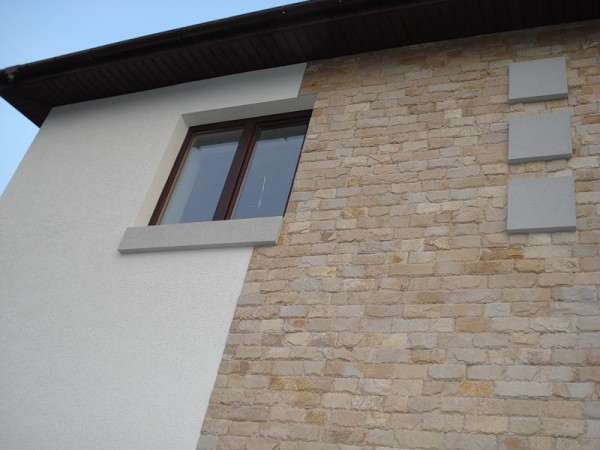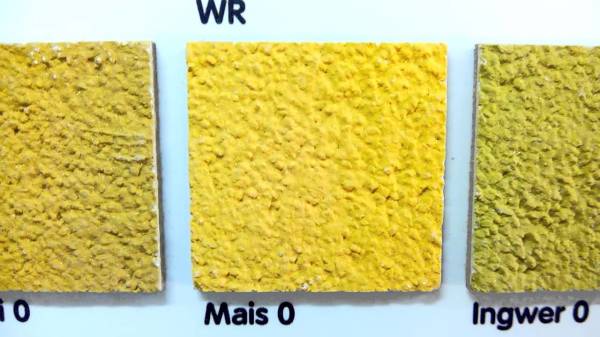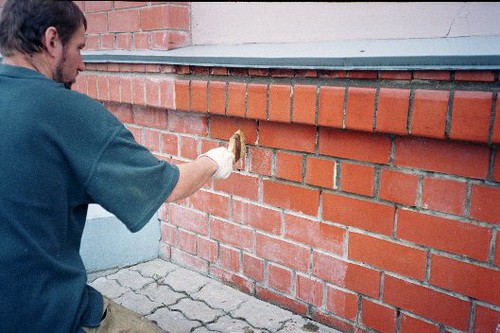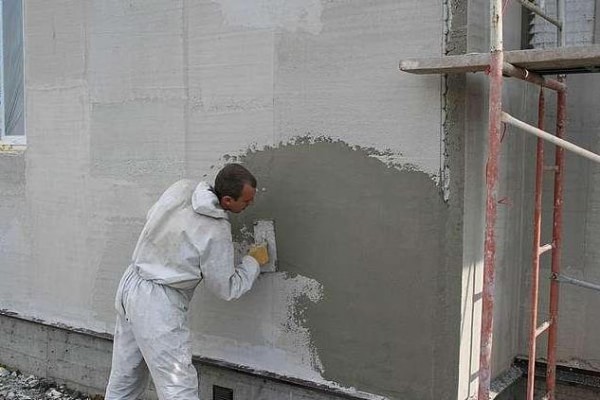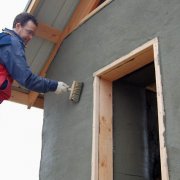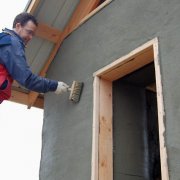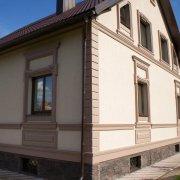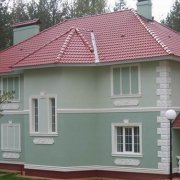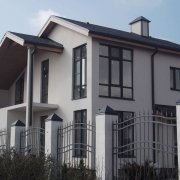How is plastering the facade of the house
Stucco decoration of the facade of the house is steadily popular. This type of finish allows you to get a reliable, environmentally friendly and breathable coating that will protect your home from rain and wind.
Decorative plaster for the facade of the house has a large selection of colors and textures will give the house an individuality, and the facade will always look neat and tidy. In order for the coating to please you for many years, you need to choose the right material, prepare the surface and adhere strictly to the technology of the work.
Today you can see this all on the video in this article and instructions on the rules of work will be offered.
The content of the article
The main types of facade plasters
Stuccoing the facade of the house with plaster is done after the right choice of material. Before proceeding to facade cladding, you need to determine which type of plaster is best for you.
The modern market offers to buy goods of four main types:
| Mineral based composition | Plaster for facades of houses is available in the form of a dry mixture based on cement. Contains chemical additives that increase the moisture resistance and elasticity of the material. Among the advantages are strength, vapor permeability, ease of application and reasonable price. Disadvantages - scanty color scheme, low elasticity (cracks may appear). The average life is 10 years. |
| Silicate based composition | This is essentially mineral plasterin which liquid glass is used as a binder component. Available in the form of a ready-made solution. Pros - high vapor permeability, well laid down on porous materials. It will last at least 25 years, while the facade will always look clean and well-groomed (dust and dirt does not stick and is easily washed off). |
| Composition on acrylic basis (polymer plaster) | Durable and durable material with good elasticity. Available in the form of a ready-made solution. Resistant to temperature extremes, mold and microorganisms. The service life is 25 years. Disadvantages - low vapor permeability and complexity of care. Acrylic plaster burns out in the sun and is very polluted. |
| Silicone based composition | Reliably protect the facade from rain and wind. Suitable for use in difficult weather conditions. It does not attract dust and dirt, and does not fade in the sun. Gives a strong, crack-resistant coating with high vapor permeability. A rich color scheme allows you to order goods of almost any color. The only drawback is the high price. |
Caution: It is important to consider the covering ability of the material. Mineral and silicate plasters are a thick-layer type of coating. They lie on almost any surface. Acrylic and silicone plasters are thin-layer, so it is better to apply them on a smooth prepared base.
Color and texture
Exterior decoration of the house with stucco can be of different colors. Each type is presented in its own color scheme. In mineral plasters, the choice of colors is limited, and the composition based on silicone allows you to choose from 200 shades.
Along with tinted plasters, you can buy white goods intended for painting. Choosing between glossy and matte colors for a plastered facade it is better to choose a matte version, because gloss will emphasize all the roughnesses and surface roughness.
Using decorative facade plaster, you can choose not only color, but also texture. Relief surfaces are obtained by adding fillers of different structures and sizes to the solution.
It could be:
- Quartz sand;
- Granite crumb;
- Marble chips (see Facade stucco with marble chips: types, features, application methods);
- Granules of polymers.
Fillers can be a part of decorative plaster individually or in various combinations. This creates a relief on the surface of the facade.
The most common options are:
- Natural stone finish;
- Venetian plaster;
- Bark beetle;
- Lamb;
- Fur coat, etc.
In order not to get lost in the variety of forms and shades, it is most reasonable to order the goods according to the catalog, which clearly shows all the colors and textures of decorative facade plaster.
Surface preparation
Exterior plastering of the house is done on a pre-prepared surface. For a new house, you can start work in 2-6 months after the completion of the walls and roofing. That is how much time is needed to upset a brick or block structure.
Attention: If the house is wooden, the period increases to 12-18 months. Before finishing, it is necessary to finish all work on installing door and window openings, arranging balconies, installing drain and drainpipes, in a word, all work on the outer surfaces of the walls.
- Walls that have already been treated will have to be cleaned of paint or traces of the previous finish. Dust, dirt, traces of mold or rust and other contaminants must be removed.
- Work can be carried out on surfaces whose temperature is above + 5 ° C. Processing frozen walls, work in the rain and at temperatures above + 30 ° C is not allowed, unless otherwise specified in the manufacturer's recommendations.
Consider the main stages of preparatory work for various building materials. It can be decorative plaster of the facade of the house or the use of another material, it does not matter.
| Brick surface | For better adhesion of the plaster with the brick, it is necessary to open the seams, make notches on them with a depth of 5-15 mm (the deeper the seam, the stronger the notch). Coat the surface with a primer and allow to dry. |
| Walls of blocks | Seam notches are also required. Fill chips and cracks with putty and treat the surface with soil. The plaster should have high vapor permeability and be less durable than the base. |
| Wood surface | All cracks and holes present on wood must be caulked. On the surface you need to apply shingles (a grid of thin rails), clean and moisten the wall. |
Attention: Beacons (long guides installed along the wall in level) will help to apply the plaster evenly. They greatly simplify work, especially on surfaces with a strong slope. If the expected layer of plaster is more than 3 cm, it is necessary to install a reinforcing mesh.
We are preparing the plane
Now we will consider how to properly plaster the facade of the house and correctly complete the preparation. After all, only in this case will it be durable and reliable.
So:
- Plaster decorative facade of the house is placed on a cleaned surface. If there was a previous coating, then it should be removed.
- After that we pull the fishing line along the diagonals of the room and look. It will immediately become clear which layer is required.
- After this, it is necessary to make reinforcement. We stretch the construction mesh. It is mounted along the plane of the walls. Make sure there are no bulges. It should be fixed evenly.
- Now apply the primer. To do this, it is better to apply deep penetration. And yet, it is worth doing the processing a couple of times. This will strengthen the bonding of surfaces.
Putting plaster mix on a house facade
Plastering the facade of the house with your own hands is done in stages.The plaster is sold as a dry mix or mortar, which is completely ready for use.
In any case, read the manufacturer's instructions. It usually indicates how to prepare the plaster mix, in what time frame it should be used and under what conditions work can be done.
Putting plaster on the outer surface of the walls is carried out in three stages:
| Splashing | Plaster with force is thrown on the walls using a bucket or brush, or applied to the surface with a brush. The solution should be sufficiently liquid (sour cream consistency), but at the same time stick to the wall and do not drain. The thickness of the layer is not more than 0.5 cm. Allow the coating to dry for 2 days. |
| Primer | Produced in a thicker solution. The thickness of the layer depends on the condition of the wall and its slope. It is desirable that the total thickness of the coating in three layers does not exceed 5 cm, otherwise the layer may peel off and everything will have to be started anew. The solution is aligned with the rule, moving along the beacons. Eliminate roughness and roughness at this stage is not necessary, they contribute to better adhesion. This layer will dry from 2 to 15 days, depending on its thickness. |
| Nakryvka | It is applied with a thickness of 0.5 cm. The layer should be dense, continuous and without breaks. Allow the mortar to set, but not dry completely and proceed to grout (using a grout). Let the surface dry. |
Attention: As the last layer, decorative plaster or paint compound can be applied (then it must be treated with a deeply penetrating primer).
Plastering the facade of the house is a difficult process, but creative and interesting. And if everything is done correctly, your house will not only look great, but will also last much longer.
How to plaster a house from the outside, you know, now it’s worth making a purchase of quality materials. Having done the work yourself, the price will not only be reduced, but it will also be a guarantee of the quality of the work.
